Abstract
In this paper, we quantify the water balance of Jessour at the scale of agricultural plots. Jessour (plural of Jesr) are ancestral hydro-agricultural systems in the Dahar plateau (southeastern Tunisia). They consist of small dams built across wadis and gullies, which retain rainwater and sediments, hence enabling cropping. Despite arid climate conditions, Jessour allow the culture of the olive tree beyond its ecological limits. Weather monitoring stations were set up and soil moisture sensors installed down to a depth of 1.25 m in the soil in two neighboring gullies in the village of Zammour: one with a Jesr and one without. Laser granulometry and organic matter analyses were carried out on samples collected near the soil moisture sensors. Measurements were recorded from 28 September 2017 to 21 September 2018. From 10 to 12 November 2017, the region received 123.3 mm rainfall. The Jesr retained the equivalent of 410.3 mm of soil moisture to a depth of 1.25 m whereas the value in the gully was 224.6 mm. Throughout the summer of 2018, the soil available water capacity (AWC) remained above 55 mm in the Jesr, while it dropped to zero in the gully. Jessour are thus very suitable hydro-agricultural systems to face the climate changes concerning this fragile region, located in the transition zone between the semi-arid to arid Mediterranean region and the Sahara.
1. Introduction
Access to water for irrigation is a critical issue in dry areas as it affects people’s livelihoods, land productivity and society in general [,,,]. On the arid plateau of Matmata-Dahar in Southeast Tunisia, the Jessour (plural of Jesr) are traditional water harvesting techniques widely used for growing crops and fruit trees, allowing for instance the cultivation of olive, almond and fig trees beyond their climatic zone [,,]. Jessour consist of small dams built across gullies and wadi thalwegs, creating a succession of terraces that partially retain the surface water and sediments required for crop growth.
Until now, research on the role of Jessour in exploiting runoff has mainly focused on the description of their structures and modes of operation [,,,,,,,] particularly their morphology [,,,,,,]. Collective management and traditional techniques [], local water management [,] and related socio-economic aspects [,] are also documented. From a hydrological standpoint, qualitative studies underlined the benefits of Jessour [,,] but not in quantitative terms, i.e., water volumes, soil humidity or available water capacity (AWC), until a very recent quantitative study of the impact of Jessour on the local water balance. Ouessar et al. [] and Abdelli et al. [] adapted the SWAT hydrological model by including the Jessour in the water balance at the watershed scale. Abdelli et al. [] documented changes in soil moisture in three Jessour in the region of Matmata (Southeast Tunisia) based on monthly data in four consecutive years and proposed benchmark values on Jessour soil water retention, in quantitative terms and at the scale of a Jesr unit. However, these studies only focused on Jessour sites. We thought it would be interesting to measure the difference in soil moisture inside and outside a Jesr to measure the added value of a Jesr unit in terms of water retention. Daily measurements would be necessary to analyze the soil water dynamics, coupled with continuous field data logging of soil moisture and rainfall []. Soil water retention and soil hydraulic properties are two well-established parameters [,] that could be used to evaluate water retention in Jessour soils. Moreover, water consumption by olive trees is well documented [], in particular in Maghreb regions []. The soil retention dynamics of Jessour, which allow the cultivation of olive trees, thus needs to be analyzed in parallel with the vegetative growth cycle and water needs of the olive tree.
The aim of the present study was to evaluate how much water could be stored in a soil whose catchment is equipped with a Jesr (see also []). Our main objective was to evaluate the differences in soil hydraulic properties between a cultivated plot with a Jesr and an uncultivated plot with no Jesr. To this end, a field campaign was conducted in Southeast Tunisia. During the campaign, three major rainfall events occurred and were measured. The evolution of soil moisture at short time scales (hours and days) was analyzed in three key periods of the year: winter rains, spring drying period and summer thunderstorms. The available water capacity was calculated and correlated with potential evapotranspiration, with respect to the olive tree vegetative cycle. Finally, we investigated what types of rainfall events (intensity and volumes) activate water retention in the Jessour.
2. Study Area
The Jesr instrumented in this study is located in the village of Zammour, in Southeast Tunisia. Zammour is part of the Beni Khedache municipality, located on the Matmata-Dahar plateau (Figure 1). This “Djebel” (Tunisian for “mountain”) is situated between the Jeffara plain, bordering the Mediterranean Sea and rich in sebkhas, and the eastern limits of the Sahara. It culminates at 713 m a.s.l. and is composed of a system of cuestas that gently incline to the west. The village of Zammour is located at an altitude of 540 m a.s.l. and lies on the cuesta back slope, which forms a depression covered by a layer of Quaternary fine sand and silt (or loess) several meters thick [,,,]. These fine sandy and silty deposits are the agricultural “wealth” of the region, which would otherwise lack soils deep enough for annual crops [,].
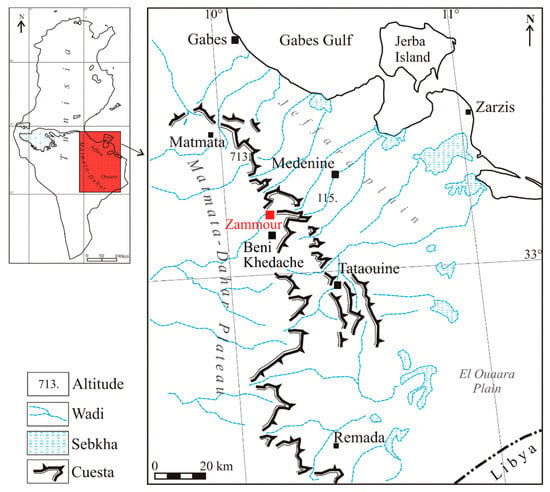
Figure 1.
Location of the study area (Zammour) on the Matmata-Dahar plateau, Southeast Tunisia. Modified after Ben Fraj et al. [].
The Matmata-Dahar plateau is located in the upper arid bioclimatic region [] in the transition zone between the Sahara to the south-west with a subtropical, hot dry climate and central Tunisia to the north, influenced by a relatively temperate Mediterranean climate []. The rainfall regime is of Mediterranean type and the rainy season lasts from September to April. There are only a few rainy days (on average 30–40 days per year) but rainfall events can be of high intensity, with a 20 year-return period maximum rainfall exceeding 100 mm/day []. Maximum rainfall in 24 h measured in Beni Khedache (1990–2004) and Medenine (1968–2004) were respectively 140.0 and 147.1 mm according to the Tunisian Meteorological Institute (Table 1) [,]. The average annual rainfall is a little higher in Beni Khedache (271.5 mm over the 1990–2004 period) than in Medenine in the Jeffara plain (186.5 mm over the 1968–2004 period) because of the higher altitude of the plateau []. Mean annual air temperature is slightly above 20 °C in both places. Summers are hot, with average temperature in July–August between 29 and 30 °C. Absolute maxima are much higher (up to 48.0 °C in Beni Khedache), due to hot dry Saharan winds that can cause temperatures to reach between 40 and 50 °C and reduce air humidity to 10% []. This dry climate, combined with hot temperatures, causes high evapotranspiration rates, with values above 2000 mm/year in Beni Kheddache. Winter temperatures are milder (on average 11–13.5 °C from December to February), but evaporation is still active (on average 110–140 mm/month in winter) due to prevailing southern to western continental winds that dry out the soils. Such severe climatic conditions results in a negative climatic water balance [], which is very constraining for rain-fed agriculture, and explains the development of water-harvesting techniques such as the Jessour in this region [,,].

Table 1.
Main climate features in Beni Khedache (1990–2004) and Medenine (1968–2004) in Southeast Tunisia according to the National Meteorological Institute of Tunisia [,].
3. Materials and Methods
3.1. Description of the Jessour System
The Jessour form a hydraulic unit made of three main components (Figure 2a,b): (1) a dam (locally called Tabia or Ketra) between 2 and 5 m high and between 15 and 50 m long across the thalweg [], in the form of a small earth embankment, sometimes reinforced with stones, with a lateral spillway called Menfes or a central spillway called Masraf, made of stones; (2) a terrace, which includes the cropping area called Khliss and (3) an impluvium, which is the runoff sub-catchment area [,].
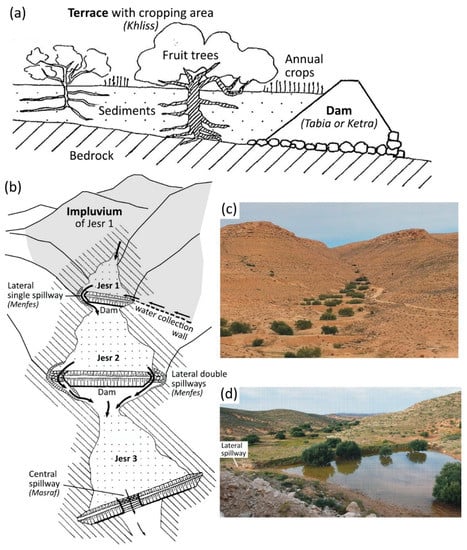
Figure 2.
(a) View of a Jesr, adapted from Bonvallot []; (b) general view of Jessour with lateral single spillway (Jesr 1), double spillway (Jesr 2) and central spillway (Jesr 3), adapted from Bonvallot []; (c) Jessour alignment, note the contrast between arid barren slopes and the bottom of the thalweg in the Jessour (photo: T. Ben Fraj) and (d) Jesr retaining part of the rainwater (photo: Tarek Ben Fraj, taken on 22 November 2017 in the Matmata region).
The role of Jessour is to take advantage of short rainfall events that occur especially in autumn and winter by collecting and slowing down runoff from the impluviums. Jessour usually succeed one another along a valley thalweg (Figure 2c) and form terraces from which water overflows into the following one after intense rainfall events. This system favors deep infiltration and enhances soil water storage by creating a small aquifer in each Jesr. The accumulation of sediments (silt and fine sand) behind the dams also provides nutrients to crops []. Cereals (lentils, peas and oats) are cultivated around fruit trees when rainfall leaves standing water in the Jessour and moistens the upper soil layers. Small walls are often built on the slopes to collect and redirect water outside the natural catchment to extend the impluvium area. Spillways and dams are dimensioned by locals to ensure a fair share of water pouring into each Jesr and the majority of spillways are only 50 cm in height to limit their retention capacity []. Part of the runoff water forms temporary ponds (Figure 2d) up to the level of the spillways when the retention capacity is reached. As Abdelli et al. explain [], it can be easily estimated that for a Jesr with a 50 cm-high spillway and a surface of 200 m2 (thus forming a retention capacity of 100 m3), 10 mm of runoff over an impluvium of 10,000 m2 could be sufficient to activate the Jesr.
3.2. Location of Instrumented Sites (JESR and Gully)
To highlight the effect of the Jessour unit on soil hydraulic properties, two measurement systems were placed on two neighboring impluviums: in a cultivated Jesr and in a gully with no hydraulic infrastructure (Figure 3).
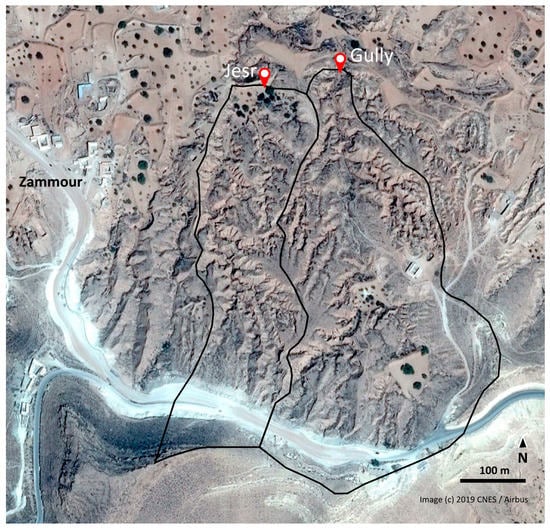
Figure 3.
Location of the two measurement systems in the Jesr and in the gully, with their impluvium.
The sites were chosen to represent similar local geology, soil texture, climate and impluvium topography. They are situated in the Chaabet el Fougania sub-catchment, a tributary of the Wadi Zammour. The gully impluvium has an area of 129,400 m2, whereas the Jesr impluvium is smaller, with an area of 76,000 m2.
3.3. Experimental Setup
The field campaign lasted one year, with continuous measurements from 28 September 2017 to the 21 September 2018. The two measurement systems comprised a weather station and a 1.25 m deep soil pit (Figure 4a–c).
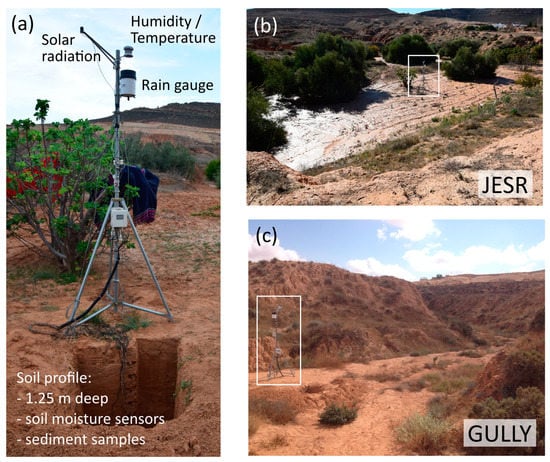
Figure 4.
(a) Components of the measurement system; location in (b) the Jesr and (c) the gully. Photos: Martin Calianno.
The weather station consisted in a bucket rain gauge, a sheltered sensor that measures humidity and temperature and a pyranometer that measures solar radiation (Figure 4a, Table 2). A datalogger recorded the meteorological parameters at a two-hour time step. In order to create a soil moisture profile, the soil station was equipped with eight volumetric water content sensors, placed at 15 cm intervals in the soil pit. The uppermost sensor was placed 20 cm below the soil surface. The soil moisture sensors used were ECH2O probe model EC-5 (Decagon Devices Inc., Pullman, WA, USA), which make an indirect evaluation of the volumetric water content by capacitance []. A datalogger recorded the soil moisture parameters at a six-hour time step.

Table 2.
Equipment installed at the measurement stations, parameters measured, units and time steps.
In parallel, soil samples were collected next to each water sensor for laboratory analysis. The soil texture was derived from particle size distribution obtained by laser granulometry. Soil texture and the range of particle sizes were defined according to the WRB classification, i.e., clay (<0.002 mm), silt (0.002–0.063 mm) and sand (0.063–2 mm) []. Finally, the total organic carbon content of the soil samples was measured using the Rock-Eval pyrolysis technique to provide the proportion of organic matter (%OM) in the soil [].
3.4. Calculation of Soil Available Water Content (AWC)
The available water content (AWC) is the amount of water contained in the soil that can be reached and extracted by plants. It is a useful parameter to evaluate the ability of the Jessour to harvest and store soil water for a cropping system. The AWC lies between soil moisture at the wilting point (θWP) and soil moisture at field capacity (θFC) [].
θWP < AWC < θFC.
Above field capacity, the soil is saturated and plants can asphyxiate. Below wilting point, the plant does not have sufficient root suction forces to absorb water.
The soil moisture at field capacity is the amount of soil moisture or water content held in the soil after excess water has drained away and the rate of downward movement has decreased. This usually takes place 2–3 days after rainfall or irrigation in pervious soils of uniform structure and texture: the water is retained in the soil by suction []. For the majority of plants grown under temperate climates, the field capacity is defined as the bulk water content retained in the soil at −0.33 bar suction pressure [].
The soil moisture at the wilting point is the minimum soil moisture the plant requires not to wilt: the plant no longer has sufficient suction forces to withdraw water from the soil. The physical definition of the wilting point is defined as the water content at −15 bar suction pressure [].
In the Jesr and the gully, θWP and θFC were estimated for every soil layer (i) using Rawls′ formulas []. These empirical relations are based on soil texture (%Sand; %Clay) and organic matter content (%OM).
Based on soil moisture data, the AWC is calculated for every soil layer (i) as follows:
when θ (i) ≥ θFC (i):
when θWP (i) < θ (i) < θFC (i):
when θ (i) ≤ θWP (i):
Then values are summed for the whole soil profile:
3.5. Calculation of Potential Evapotranspiration (PET) Using the Turc Formula
The Turc formula [] was used to calculate a daily potential evapotranspiration (ET0) time series from solar radiation (Rad; cal/cm2/day), relative humidity (RH; %) and mean daily temperatures data (T; °C):
when RH ≥ 50%:
when RH < 50%:
The Turc formula was chosen because it is a robust empirical method that requires fewer data than the Penman formula. Moreover, it is suitable for arid regions. In their comparative study of evapotranspiration formulas applied to southern Tunisia climatic data, Damagnez et al. found that the results obtained with the Turc formula were similar to results obtained with the Penman formula [].
4. Results
4.1. Characteristics of Soil Layers
The results of laser granulometry (Table 3) indicate that the Jesr and gully profiles had almost identical soil textures, composed mainly of loams.

Table 3.
Soil sample analysis for each layer in the Jesr and gully profiles: texture class, organic matter content and soil moisture content at field capacity (θFC) and at wilting point (θWP).
The granulometry of both profiles increased with soil depth and became increasingly sandy. Both soils consisted of loams in the shallow layer (−20 cm), sandy loams from −35 to −50 cm and loamy sands in the deepest layers (from −65 to −125 cm). An exception to this variation was the sandy loam layer at −110 cm in the gully. Note also that in the −125 cm layer in the Jesr, classified as sandy loam, the proportions of sand are close to those in the loamy sand class.
As a result of such similar soil textures, the θFC and θWP values calculated from Rawl′s formulas were almost the same in the two profiles, with an average θFC of 0.14 m3/m3 (0.136 m3/m3 for the Jesr, 0.143 m3/m3 for the gully) and an average θWP of 0.05 m3/m3 (0.048 m3/m3 for the Jesr, 0.051 m3/m3 for the gully). These values were in the same range as those measured by Abdelli et al. on soils in Jessour in the neighboring Matmata region and had similar textures []. Since Zammour soils are almost not used for agriculture and have a low organic matter content, the potential maximum available water content in the 1.25 m profiles was quite low: 0.09 m3/m3 on average.
4.2. Meteorological Context and Significant Rainfall Events
From 28 September 2017 to 21 September 2018, 291.5 mm of cumulated rainfall was measured in the Jesr site, and 279.3 mm was measured in the gully site. These values were slightly higher than the average annual precipitation (271.5 mm) measured in Beni Khedache from 1990 to 2004 (Table 1). Both weather stations recorded 30 rainy days like in Beni Khedache from 1990 to 2004 (Table 1). Rainfall values measured in the Jesr site were consistently higher than in the gully, with a mean deviation of 4%. We considered that this bias was due to the calibration uncertainty between the two rain gauges. In Figure 5, the rainfall values shown are the average of Jesr and gully values.
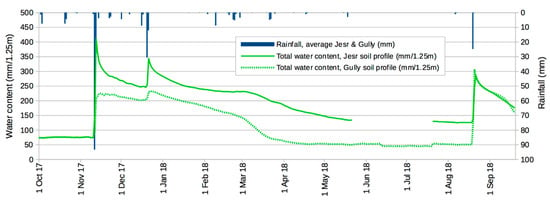
Figure 5.
Total water content in the Jesr and gully soil profiles and daily rainfall (values are averages of the Jesr and gully).
Three rainfall events led to a significant rise in soil moisture in both study plots (see also Table 4):

Table 4.
Left table: evolution of total water content in the Jesr and gully soil profiles throughout the monitoring period and at two key moments after rainfall events. Right table: recharge in water content corresponding to the peak of water content in the Jesr and in the gully following each rainfall event. The rainfall events are highlighted in grey.
- -
- 10–12 November 2017: 123.2 mm fell in 38 h, i.e., 3.24 mm/h;
- -
- 20–21 December 2017: 45.0 mm fell in 32 h, i.e., 1.44 mm/h;
- -
- 19 August 2018: 26.7 mm fell in 6 h, i.e., 4.45 mm/h.
These three rainfall events were sufficiently intense to trigger runoff in the gully and activate the Jesr. The exceptional rainfall volumes on 10–12 November 2017 fully activated the Jesr and left a significant amount of standing water in the cultivated plot and also caused severe damage to several Jessour in the Zammour area [].
Other observed rainfall events were all below 10 mm in 24 h (0.4 mm/h) and did not significantly influence the whole soil moisture profile (Figure 5); variations in soil moisture were only observed in the first 20–30 cm layer.
The intense rainfall event, which lasted from the evening of 10 November 2017 until the morning of 12 November 2017, followed a northern cold air descent that favored an active front in southeast Tunisia in contact with the hot air of the Sahara []. This depression sucked in moist air from the Mediterranean Sea and caused heavy thunderstorms over southeast Tunisia with 123 mm in Zammour and 167–195 mm in 48 h in Jerba, Medenine and Zarzis. Such episodes have a return period of at least 20 years and are described in detail in Ben Ouezdou et al. [].
The second significant rainfall event on 20–21 December 2017 occurred following an influx of humid eastern air from the Mediterranean caused by a strong anticyclone covering a large part of Europe. A warm front was located over the most southern part of Tunisia.
The third rainy episode on 19 August 2018 occurred when the situation was similar to that of the second episode, but the anticyclone over Europe was less powerful. It caused an influx of humid air from the north to the eastern Mediterranean then into Tunisia. That day an altitude front descended in the south and caused violent storms with hail in northern Tunisia, especially in Tunis, before reaching the south of the country. It generated two rainfall events of 5.7 mm/h and 7.6 mm/h on 19 August 2018 in Zammour.
Regarding temperatures, the average difference between temperatures measured in the Jesr and the gully sites was less than 0.1%. Temperatures during our study period were generally cool due to the particularly humid winter, with an annual mean temperature of 18.6 °C. This value is below the average annual temperature measured in Beni Khedache from 1990 to 2004 (20.1 °C, see Table 1). Summer temperatures were in the normal range, with an average of 28 °C. The maximum daily temperature in July (the warmest month) was 37.3 °C, while the July maximum daily normal was 35.7 °C in Beni Khedache from 1990 to 2004 [].
4.3. Seasonal Water Content Dynamics in the Jesr and Gully Soil Profiles
This section describes the evolution of total soil water content in the Jesr and gully soil profiles during the monitoring period (Figure 5). A technical problem lasted from 22 May 2018 to 19 July 2018, resulting in a gap in the soil moisture record in the Jesr site. Fortunately, no significant rainfall event occurred during this period.
Table 4 lists the differences in total soil water content between the Jesr and the gully throughout the year, as well as recharge after the significant rainfall events. The total water content in the soil profiles in mm/1.25 m (liters/m2, down to a depth of 1.25 m) was obtained by integrating the soil moisture values of each layer of soil (in m3/m3) by their corresponding thickness, over a surface area of 1 m2. The recharge corresponds to the difference in total soil water content before and after rainfall events.
The evolution of volumetric water content (θ) measured by the eight sensors in the Jesr and the gully was analyzed in more detail in three particular periods: the 2017 autumn rainfall events (Figure 6), the spring 2018 drying period (Figure 7) and the thunderstorm on 19 August 2018 (Figure 8).
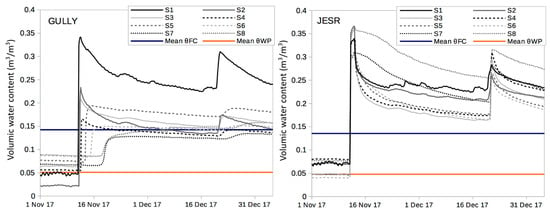
Figure 6.
Evolution of soil moisture at different depths (eight sensors) in the gully and the Jesr after the 10–12 November 2017 rainfall event.
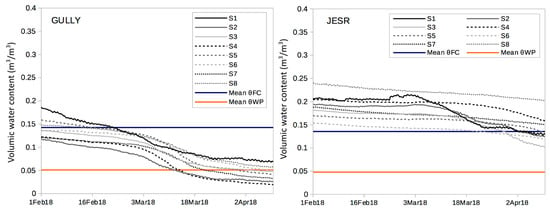
Figure 7.
Evolution of soil moisture at different depths (eight sensors) in the gully and the Jesr during the soil drying period (February–April 2018).
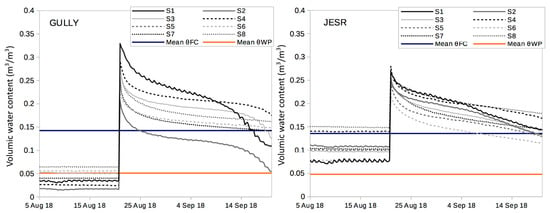
Figure 8.
Evolution of soil moisture at different depths (eight sensors) in the gully and the Jesr after the thunderstorm on 19 August 2018.
In each figure, the values of θWP and θFC averaged over the whole soil profile are indicated as benchmarks.
4.3.1. Late Summer 2017
After the 2017 summer period, the Jesr and gully soil profiles were almost dry with similar water contents: 73.7 and 74.3 mm/1.25 m, respectively (Table 4). This situation is to be expected because the soils in the Jesr and gully have almost identical textures and therefore similar long-term water retention capacities.
Considering each soil layer in detail (Figure 6), the soil moisture in both profiles stabilized to around their average wilting point (0.05 m3/m3). The gradient of soil moisture between soil layers in the gully was steeper than in the Jesr. In the gully, there was a clear increase in soil moisture with depth: the driest layers were those closest to the surface (S1 and S2) and the most humid layers deeper in the profile. In the Jesr, there was no apparent link between soil moisture and the depth of the layers, the differences in soil moisture were mostly controlled by the soil characteristics. In particular, the presence of organic matter enhanced the water retention capacity. The S1, S2, S4 and S8 sensors recorded the highest soil moisture contents, and also the highest percentage of organic matter. The driest layers were those with the lowest organic matter content (S3, S5, S6 and S7).
4.3.2. Rainfall Events in Autumn and Winter 2017
There was an abrupt increase in water content after the 10–12 November 2017 rainfall event when all the soil layers approached saturation. On 12 November, right at the end of the rainfall event, all eight sensors in the Jesr simultaneously recorded high water content, with values ranging from 0.3 to 0.36 m3/m3. The peak in total water content in the Jesr soil profile (410 mm/1.25 m; Figure 5, Table 4) was already visible on the second rainy day and was almost twice as high as that in the gully (224.6 mm/1.25 m). The peak in the Jesr lasted for two days, indicating a pond was formed in the Jesr. This situation led to the saturation of the entire soil profile. In the gully, there was also a significant rise in total water content immediately after the 10–12 November rainfall event (207.5 mm/1.25 m), but the maximum value (224.6 mm/1.25 m) was only reached three days later. As there was no pond water in the gully, we considered that the additional 17.1 mm came from longitudinal and lateral subsurface flows. At the soil layer scale (Figure 6), the peak low water content in the gully was clearly explained: only the upper part of the soil profile (S1 to S4) was moistened at the end of the rainfall event. Apart from S1, at 0.35 m3/m3, the values were lower than in the Jesr: 0.2 m3/m3 for S2 and S3, and 0.16 m3/m3 for S4.
During the 3–4 days following the peak, there was a marked drop in water content due to drainage of excess water, until values close to field capacity were reached (Figure 6). This down slope drainage was clearly visible in the Jesr because the entire soil profile was close to saturation after the rainfall event and the excess water drained away outside the profile. A very sharp decrease in volumetric water content was recorded by the six first sensors, as excess water in the shallowest layers drained away after the pond disappeared. However, the two deepest layers (S7 and S8) drained much more slowly and water content values remained high (respectively 0.3 and 0.35 m3/m3) until one week after the rainfall event. Such rapid drainage did not happen in the gully in terms of total water content because the excess water draining from the upper layers was transferred into the lower layers, which are still included in the 1.25 m profile. This water transfer was apparent at the layer scale (Figure 6), with soil moisture peaks reaching the deeper layers, respectively three days later (S5), six days later (S6) and 13 days later (S7 and S8). Once soil moisture values close to field capacity were reached, the downward slopes in water content were less pronounced, indicating the much slower drainage of interstitial water. This situation was observed particularly in winter, when upward drainage due to evapotranspiration was low.
After the November event, the water content recharge (335.6 mm in the Jesr and 150.3 mm in the gully; Table 4) was well above the average rainfall measured at the two stations (121 mm). This highlights the high runoff volumes that can be generated during intense rain events on the Dahar plateau, as also illustrated by the high runoff coefficient reported by Ouessar et al. in the same region []. Despite having a smaller impluvium than the gully, the Jesr demonstrated its very high capacity to collect, infiltrate and store runoff water after this rainfall event.
After two weeks of drainage, the majority of soil layers in the gully reached the average field capacity (Figure 6), with soil moisture values ranging from 0.14 m3/m3 deeper in the profile (S7 and S8) to 0.18 m3/m3 in the middle of the profile (S5). Only the shallowest layer (S1) still showed high values (0.25 m3/m3). In the Jesr, the moisture content of the soil layers was still very high, with values ranging from 0.18 to 0.3 m3/m3. Unlike in the gully, the wettest layers were the bottom layers, with values above 0.25 m3/m3 (S7 and S8) and the driest layers were in the middle of the profile (S3, S4 and S5). The two layers close to the surface (S1 and S2) drained more slowly after the drop following the rainfall peak and still showed high values (respectively 0.24 and 0.23 m3/m3) two weeks after the rainfall event. This situation was caused by the small rainfall events (<10 mm in 24 h) that occurred between 13 November and 19 December 2017 (see Figure 5), which moistened the soil layers near the surface, but not deeper.
One and a half months later, in winter, as the soil profiles were still humid (246 mm/1.25 m in the Jesr and 202.5 mm/1.25 m in the gully), the rainfall event on the 20–21 December 2017 led to new peaks in water content in both sites (Figure 6, Table 4). Again, the maximum water content in the Jesr (343.8 mm/1.25 m) was higher than in the gully (232.9 mm/1.25 m). Two days after the rainfall event, the Jesr contained 36% more water than the gully and two weeks later, after the excess water in the Jesr soil had drained away, it still contained 29% more water.
At the soil layer scale, the December rainfall event triggered similar responses to those in November. The whole soil profile was moistened in the Jesr, suggesting the formation of a new pond, whereas in the gully, only the layers close to the surface were moistened.
After the December event, the recharges were lower than in November because the soils were already well moistened after the November rainfall event. With the average rainfall of 43 mm, the recharge was 97.8 mm in the Jesr and 30.4 mm in the gully.
4.3.3. Dry Season: Spring and Summer
After these two winter rainfall events and until early spring, the Jesr soil profile drained more slowly and retained water more efficiently than the gully. From early spring on, the rise in temperature increased evaporation. At the same time, the plant vegetative cycle resumed and their need for water increased. After 1 March 2018, a break occurred in the water content slope (Figure 5). From this moment on, the soils drained at higher rates and drainage was even higher in the gully. On 1 March 2018, the Jesr contained 64% more water than the gully, and one month later, on 1 April 2018, almost three times more water (+196%, Table 4).
At the soil layer scale (Figure 7), from February to April, volumetric water content in the gully changed from values close to field capacity to values close to the wilting point whereas in the Jesr, values remained at field capacity. In the gully, all the soil layers were draining at the same rate but in the Jesr, drying was more marked in the three shallowest layers (S1, S2 and S3) whereas in the deeper layers, water content remained relatively stable.
Finally, water content remained stable throughout the summer season when the curves formed a plateau. Already in mid-April 2018, the gully was almost entirely drained (there was no further reduction in water content), whereas on 20 July 2018, the Jesr still contained much more water (+145%) than the gully. It is also interesting to note that in summer 2018, the water content in the gully (52.9 mm/1.25 m on 20 July 2018) was lower than after the summer 2017 (74.3 mm/1.25 m on 1 October 2017; see Table 4).
4.3.4. Thunderstorm on 19 August 2018
After the August rainfall event, the peak water contents were similar in the two soil profiles (see Figure 5). Nevertheless, the maximum values in August were lower than the peaks that occurred in the Jesr after the November and December events. This time, the peak was slightly lower in the Jesr (286.9 mm/1.25 m) than in the gully (307.7 mm/1.25 m).
It is the only rainfall event in which the soil moisture in every layer in the gully exceeded field capacity (Figure 8). Since the entire soil profiles were moistened, steep drainage slopes were observed both for the Jesr and the gully in the 2–3 days following the thunderstorm.
At the scale of the soil layers, the response of the Jesr and the gully soils was similar, when all the sensors recorded soil moisture peaks directly after the thunderstorm. However, this time, the peak in the gully’s uppermost layer (S1; 0.33 m3/m3) was higher than in the Jesr (S1; 0.27 m3/m3). There was a gradient of soil moisture between soil layers in both the Jesr and the gully. These differences were directly correlated with the amount of organic matter in the soil layers, as could be observed before the rainfall event.
Two weeks after the thunderstorm, the Jesr and the gully had almost identical water contents (228 mm/1.25 m) and their drainage occurred at similar rates. However, on the 19 September 2018 (the last record), the water content in Jesr was 11% higher than in the gully, indicating that at this period, the gully drained more rapidly than the Jesr.
4.4. Evolution of Potential Evapotranspiration and Available Water Content in the Jesr and in the Gully
Daily available water capacity (AWC) and potential evapotranspiration (ET0) data in the Jesr and gully soil profiles are shown in Figure 9.
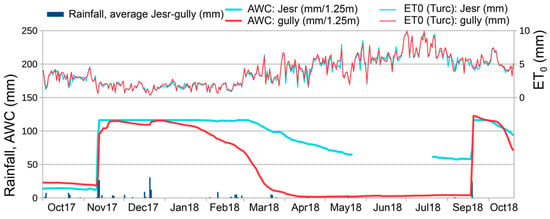
Figure 9.
Evolution of available water capacity (AWC) and potential evapotranspiration (ET0) in the Jesr and the gully.
4.4.1. Evolution of ET0
Daily ET0 values followed the same trend in the Jesr and the gully and how they evolved over the seasons is a key explanation for the evolution of AWC in soil profiles. In the early autumn of 2017 (October to mid-November), ET0 values were still relatively high, with an average of 4 mm/day. In winter (December–February), the ET0 decreased and remained relatively stable, with values between 1 and 2 mm/day. From March to June 2018, ET0 started to rise and to become more variable, with values ranging from 3 and 7 mm/day. In summer, the maximum observed ET0 was in July 2018, with peaks up to 10 mm/day. Then, from August to September, potential evapotranspiration decreased to values ranging from 4 to 7 mm/day. The cumulated ET0 for the whole monitoring period (28 September 2017–21 September 2018) was 1377 mm in the Jesr and 1403 mm in the gully.
4.4.2. Evolution of AWC
At the beginning of the monitoring campaign (October to early November 2017), the available water capacity was almost stable in both soil profiles with very little drainage (0.2 mm/day on average), barely visible in Figure 7. The AWC was low at that moment following the summer period, with higher values in the gully (22–19 mm/1.25 m) than in the Jesr (14–12 mm/1.25 m).
Even if the Jesr and the gully had the same total water content at that period of the year (Figure 5), AWC values for the Jesr were a little lower because more soil layers had reached wilting point than in the gully.
The peak in AWC formed after the 10–12 November 2017 rainfall event was sharper for the Jesr than for the gully: the Jesr values reached the theoretical maximum AWC (116.2 mm) directly after the rainfall event. The whole Jesr soil profile was saturated, with values much higher than field capacity. In the gully, the AWC did not reach its theoretical maximum value, as the two deepest soil layers were not sufficiently moistened to reach their field capacity. After the rain, the AWC in the gully slowly rose to a maximum of 114.9 mm, which was reached on the 20 November. This late maximum was certainly due to additional water supplied by longitudinal and lateral subsurface flows. After this peak, the AWC in the gully decreased very slowly to 109 mm before the December 2017 rainfall event, whereas the AWC in the Jesr remained at maximum forming a plateau that lasted until early March.
The maximum AWC value in the gully was again reached after the December 2017 rainfall event. The AWC in the Jesr was not influenced by the December rainfall event, as the soils were still sufficiently humid to ensure maximum available water storage.
From January to late February, the AWC in the gully decreased at a rate of −0.7 mm/day on average, whereas the AWC in the Jesr remained at maximum.
Starting from early March, when the evapotranspiration started to rise, the AWC in the gully decreased more rapidly, at a rate of −2.5 mm/day on average, to reach values close to zero in early April. In the Jesr, the AWC also started to decrease from early March but at a lower rate (on average, −0.6 mm/day until mid-May). Already from the 15 April, the difference in AWC between the Jesr and the gully was remarkable: there was almost no more water available for the plants in the gully (2 mm), whereas there was still 82 mm available in the Jesr.
Throughout the summer, the AWC in the Jesr continued to decrease very slowly and reached values around 58 mm in mid-August, whereas the null AWC in the gully continued.
After the thunderstorm on 19 August 2018, there was a new peak of maximum AWC in both the Jesr (116.2 mm) and the gully (122.5 mm). This time, the maximum AWC was reached in the gully because all the soil layers exceeded their field capacity.
On the following days, due to the still high temperatures in late August and September, the AWC decreased in both profiles at a rate of about −0.4 mm/day. From September 5 on, the AWC decreased at a higher rate in the gully (on average, −3.1 mm/day) to reach a value of 71 mm on 19 September, the last day of measurements. In the Jesr, the decrease was lower (−1.2 mm/day), and reached 94 mm on 19 September. In fact, even if the August rainfall event led to a highest AWC peak in the gully, the drying that followed in the Jesr was much slower and finally, the AWC in the Jesr one month later was higher than in the gully.
5. Discussion
5.1. Role of the Type of Rainfall Event in Activating Jessour
Rainfall intensity and its spatial distribution over the impluviums are two key parameters in triggering runoff and the activation of Jessour that need to be taken into account. The three rainfall events that activated the Jessour and led to significant peaks in water content over the whole soil profile had intensities above 20 mm in 24 h. Less significant rainfall events (<10 mm/24 h) did not generate sufficient runoff and infiltration to moisten the whole soil profile but only affected the upper layers.
All three significant rainfall events fully filled the Jesr soil profile with water, whereas the gully soil profile was only moistened by the thunderstorm that occurred in August 2018. This event is interesting because despite the relatively low volume of rain measured by the weather stations (24.9 mm on average), there was a significant soil water recharge (+161.2 mm in the Jesr and +256.8 mm in the gully). The recharge was higher in the gully, because before the storm, the soil column was much drier than in the Jesr. Such a high recharge may be due to the intensity of the thunderstorm (24.9 mm rainfall in only six hours), with high runoff from a bigger impluvium than that of the Jesr. Moreover, the infiltration rate may have increased in the gully due to the presence of bushes, which had grown after the humid 2017 winter (see Figure 10).
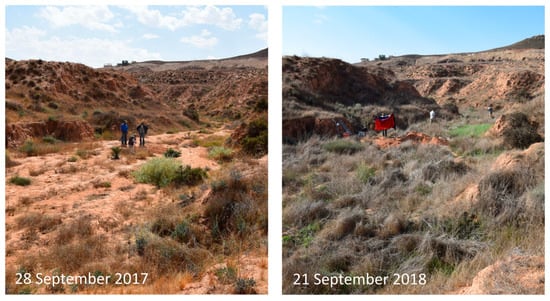
Figure 10.
Difference in vegetation cover in the gully between 28 September 2017 and 21 September 2018. Photos: Martin Calianno.
Another possible explanation for the high recharge rates could be the occurrence of a localized and intense thunderstorm that produced higher cumulative rainfall upstream of the impluviums, compared to the rainfall measured by the weather stations downstream.
We concluded that the benefits of Jessour were taking advantage of frontal, generalized regional rainfall events that occur in winter. These events are spatially well distributed and affect the entire impluviums. These winter rains are crucial for agriculture in this region and the role of the Jessour is to store water in for the coming dry period. The intense and localized thunderstorms that occur in summer are not sufficiently evenly spatially distributed to benefit agriculture throughout the region. They only affect a small number of impluviums. What is more, thunderstorms are uncommon in summer in this arid area.
5.2. Benefits of the Jessour System for the Local Water Balance
The Jessour system favored the local water balance due to three types of processes (Figure 11):
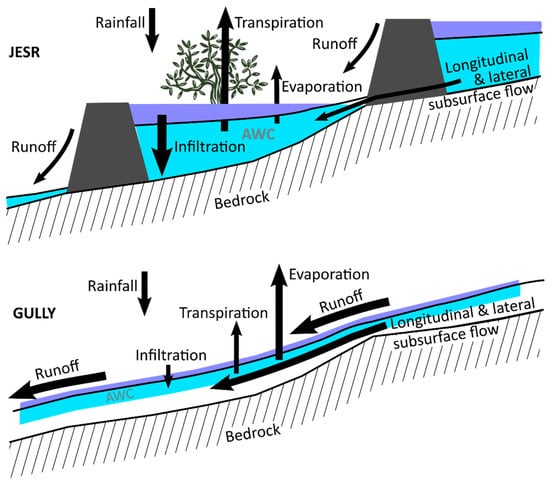
Figure 11.
Schematic water balance for the Jesr and the gully. Turquoise: infiltrated water and subsurface flow and blue: surface runoff.
- -
- First, it concentrated runoff in the Jessour plots, via dams and water collection walls;
- -
- Second, it slowed down surface runoff, created ponds and favored infiltration throughout the soil profile. Jessour could store more water by moistening the whole soil profile.
- -
- Finally, Jessour limited soil drainage, as the succession of dams created a system that was less permeable to longitudinal and lateral subsurface flows and therefore stored more water. Moreover, the terraces behind the Jessour dams created a flat landscape that helped slow down drainage and resulted in a slower drying of the Jesr soil profile in spring than in the gully. The Jesr retained soil moisture longer and preserved higher available water content.
In terms of total water content in the soil profiles, results highlighted the capacity of the Jesr to store water after the two significant rainfall events: one on 10–12 November 2017 (123.3 mm rainfall) and the other on 21 December 2017 (45 mm rainfall), with peaks of 410.3 mm/1.25 m and 343.8 mm/1.25 m, respectively. Abdelli et al. [] obtained similar results in Jessour in the nearby region of Matmata, with average values between 100 and 200 mm, and values exceeding 300 mm in wet periods. The present study showed that water storage in a gully without a Jesr structure was lower than in the Jesr after the two winter rainfall events (respectively −83% and −48%). These two rainfall events provided sufficient water for the plants for the whole summer in the Jesr, with available water content remaining above 55 mm. In the gully, the available water content had already dropped to values close to zero in early April. On 1 April 2018, the total water content in the Jesr (183.7 mm/1.25 m) was almost three times higher than in the gully (62.2 mm/1.25 m). This highlighted the capacity of the Jessour to slow down drainage and to store water longer in the dry periods, which is usually when crops need water.
5.3. Benefits of the Jesr for Soil Water Retention with Respect to the Olive Tree Vegetative Cycle
If we take the olive tree as an example, water needs are at maximum during the vegetative growth period. In Mediterranean climates, the growth period corresponds to two periods in the year: from March to June, during the spring awakening and flowering, and from September to October, during autumn vegetative development, when the olive fruits are growing []. In the summer period (July–August), the vegetative growth pauses and the olive trees reduce transpiration to adapt to the hot dry conditions. The effect of plant transpiration (as well as soil evaporation) is clearly observed in the Jesr and gully soil profiles, where water contents decreased at higher rates starting in early March. In the gully, the wilting point was already reached in early April: water was no longer available for the plants. In the Jesr, the drop in water content was slower and continued until June. During the vegetative break, the water content remained stable. If we assume that the August 2018 thunderstorm was an exceptional event, the major difference from this moment on is that the Jesr soil still had water available for autumn vegetative growth (55 mm), whereas no more water was available in the gully. In September, available water content again decreased due to the autumn vegetative growth.
5.4. Olive Tree Rooting Depth and the Depth of Soil Profiles
A debatable point is whether the depth of our soil profiles (1.25 m) is representative of the olive tree rooting depth. Olive trees can withstand the high summer temperatures if water supply is satisfactory, meaning a deep root system is necessary in a pre-Saharan climate. The roots of an olive tree penetrate to a depth of between 1.25 and 1.80 m. However, the root hairs are generally limited to the top meter of soil depending on water availability []. Below the first meter, there are roots that allow the tree to survive in the case of drought []. We therefore assume that the 1.25 m soil profile captured most of the active rooting zone of the olive trees. Nevertheless, in future studies, it would be interesting to dig soil profiles that go down to the bedrock to account for the real soil depth and to detect possible deep water fluxes at the interface with the bedrock.
5.5. Spatial Variability of Soil Content: Planting Density and Distance from the Tree Rooting System
Given the arid climate, olive trees are planted in Jessour at a very low density. When rainfall is less than 200 mm/year, the recommended density is 17 trees/ha, at a spacing of 24 m × 24 m []. In this context, the spatial variability of hydraulic properties of the soil profiles, in particular preferential flow in soil, has to be taken into account in order to establish to what degree local measurements can be extrapolated to the whole plot []. This spatial variability should be considered when interpreting the results, given that the soil water content may be higher closer to the trees and the root systems. In our case, the soil profile locations were chosen for practical reasons (not too close to the trees to avoid damaging them and to facilitate digging) and by the need to locate the weather stations next to the Jesr spillway, where ponding occurs.
6. Conclusions
Weather parameters and soil moisture profiles were measured in two neighboring sites in the village of Zammour (Southeast Tunisia), characterized by an arid climate. One site is an agricultural plot equipped with a water-harvesting dam (Jesr), the other is a gully, with no Jesr. Both sites have a similar climate, catchment area, geology and topography. The objective of this work was to evaluate the benefit of the Jesr system in terms of soil moisture retention, based on eight soil moisture sensors, placed at 15 cm intervals down to a depth of 1.25 m.
Our results show that soils in the Jesr and the gully both had a loamy to sandy loam texture, with an average soil moisture at field capacity of 0.14 m3/m3 and an average soil moisture at wilting point of 0.05 0.14 m3/m3.
During the monitoring campaign from 28 September 2017 to 21 September 2018, only three events with more than 20 mm rainfall resulted in a significant peak of water content in the soil profiles: the 10–12 November 2017 rainfall event (123.2 mm in 38 h, i.e., 3.24 mm/h), the 20–21 December 2017 rainfall event (45 mm in 32 h, i.e., 1.44 mm/h) and the thunderstorm on 19 August 2018 (26.7 mm in 6 h, i.e., 4.45 mm/h). The November and December events gave rise to peaks in the total water content of the Jesr soil profile (respectively 410.3 and 343.8 mm/1.25 m), almost twice higher than in the gully (respectively 224.6 and 232.6 mm/1.25 m). The August thunderstorm gave rise to similar peaks in the Jesr and the gully (respectively 286.9 and 307.7 mm/1.25 m). These three rainfall events caused a sudden increase in the soil moisture down to a depth of at least 125 cm in the Jesr, when precipitation reached a height of 20 mm. Above this threshold, the water flowed in the wadi and flooded the plot due to the Jesr. In the gully, the rainy episodes in November and December 2017, although more rain fell than in August 2018, resulted in a gradual and modest increase in the soil moisture content below 35 cm.
These results are in accordance with soil water storage measured by Abdelli et al. [] in Jessour in the neighboring region of Matmata, which ranges from 100 to 200 mm on average and exceeds 300 mm in wet periods. The gain in the Jessour compared to non-equipped sites was +83% of total water content after the 10–12 November 2017 rainfall event, +48% after the 20–21 December 2017 rainfall event and up to +196% on 1 April 2018, during the spring soil-drying period. The drainage of the soil profiles started at the beginning of the hot dry period corresponding to the spring vegetative growth of olive trees (early March) and was much higher in the gully, whereas the Jesr was able to store soil moisture longer. Already on 1 April 2018, the water available for plants was close to zero in the gully, whereas it was still 55 mm in the Jesr. During the hottest months (July and August), corresponding to the break in olive tree vegetative growth, the available water content remained stable in the Jesr at values above 50 mm. This highlights the capacity of the Jesr to store winter rainfall until the summer of the following year, and to keep it available for the autumn vegetative growth. The results were in accordance with those of Ben Ouezdou and Trousset [], who estimated that for rainfall of about 200 mm/year, the Jessour system can provide the equivalent of rainfall of 500 mm/year, adding that “this makes it possible to multiply the water resources by 2.5 and to significantly increase the possibilities offered to practice agriculture in arid areas”. The high hydraulic value of Jessour should encourage the authorities to promote their long-term maintenance.
After assessing the difference between sites with and without a Jesr, in September 2018, we moved the weather stations and soil moisture probes to another region of the Dahar (Zmertene). Here the objective is to compare soil moisture dynamics upstream and downstream of the impluvium of a site equipped with Jessour.
Author Contributions
Conceptualization, M.C., J.-M.F., T.B.F., H.B.O., E.R. and M.M.; Data curation, M.C., J.-M.F., T.B.F. and T.A.; Formal analysis, M.C. and J.-M.F.; Funding acquisition, H.B.O. and E.R.; Investigation, M.C., J.-M.F., T.B.F., H.B.O., E.R., M.A. and A.G.M.; Methodology, M.C., J.-M.F., T.B.F., M.M., M.A., A.G.M. and T.A.; Project administration, H.B.O. and E.R.; Writing—original draft, M.C.; Writing—review and editing, J.-M.F., T.B.F., H.B.O., E.R. and M.M. All authors have read and agreed to the published version of the manuscript.
Funding
The measurement stations were provided by the Investment Fund of the Faculty of Geosciences and Environment (FGSE) of Lausanne University. The fieldwork costs were paid by the Institute of Geography and Sustainability (IGD) of Lausanne University and by the Laboratory of Geomorphologic Cartography of Settings, Environments and Dynamics (CGMED) of Tunis University.
Acknowledgments
The sedimentological analyses were done at the Sedimentology Laboratory of the Institute of Earth Sciences (ISTE) of Lausanne University. We thank the local association “Jeunes de Zammour” for maintenance and surveillance of the equipment during the measurement periods, the territorial unit of agricultural vulgarization of Beni Khedache and the field owners, the descendants of M′hammed Ben Moussa Zammouri, for allowing us to install the equipment in their field.
Conflicts of Interest
The authors declare no conflict of interest.
References
- Baduel, A.; Baduel, P. Le pouvoir de l’eau dans le Sud-Tunisien. Revue de l’Occident Musulman et de la Méditerranée 1980, 30, 101–134. [Google Scholar] [CrossRef]
- Field, W.P. World irrigation. Irrig. Drain. Syst. 1990, 4, 91–107. [Google Scholar] [CrossRef]
- Bonvallot, J. Plaidoyer pour les jessour. In L’aridité: Une Contrainte au Développement. Caractérisation, Réponses Biologiques, Stratégies des Sociétés; Le Floc’h, E., Grouzis, M., Cornet, A., Bille, J.-C., Eds.; Didactiques: Paris, France, 1992; pp. 507–517. [Google Scholar]
- Ouessar, M.; Bruggeman, A.; Abdelli, F.; Mohtar, R.H.; Gabriels, D.; Cornelis, W.M. Modelling water-harvesting systems in the arid south of Tunisia using SWAT. Hydrol. Earth Syst. Sci. 2009, 13, 2003–2021. [Google Scholar] [CrossRef]
- Bonvallot, J. Comportement des ouvrages de petite hydraulique dans la région de Médenine (Tunisie du Sud) au cours des pluies exceptionnelles de mars 1979. Cahiers ORSTOM Série Sciences Humaines 1979, 16, 233–249. [Google Scholar]
- Abdelli, F.; Ouessar, M.; Khatteli, H. Méthodologie d’identification des ouvrages existants et des sites potentiels pour les Jessour. Revue des Sciences de l’Eau/J. Water Sci. 2012, 25, 237–254. [Google Scholar] [CrossRef][Green Version]
- Ben Fraj, T.; Abderrahmen, A.; Ben Ouezdou, H.; Reynard, E.; Milano, M.; Calianno, M.; Fallot, J.-M. Les Jessour dans le Sud-est tunisien: Un système hydro-agricole ancestral dans un milieu aride. In Proceedings of the 29ème Colloque de l’Association Internationale de Climatologie (AIC), Besançon, France, 6–9 July 2016; pp. 193–198. [Google Scholar]
- Bonvallot, J. Tabias et jessour du Sud tunisien: Agriculture dans les zones marginales et parade à l’érosion. Cahiers ORSTOM Série Pédologie 1986, 22, 163–171. [Google Scholar]
- Ben Ouezdou, H.; Mamou, A.; Hassen, M. Code des Eaux et Aménagement Hydraulique au Sud de l’Ifriquya au Moyen Age; CPU: Tunis, Tunisie, 1999. [Google Scholar]
- Ben Ouezdou, H.; Abderrahmen, A.; Abbassi, M.; Ben Fraj, T.; Calianno, M.; Fallot, J.-M.; Milano, M.; Reynard, E. Analyse de l’événement pluviométrique intense du 11 novembre 2017 et ses effets sur le système hydraulique des Jessour (sud-est tunisien). In Proceedings of the 31ème Colloque de l’Association Internationale de Climatologie (AIC), Nice, France, 4–7 July 2018; pp. 251–256. [Google Scholar]
- Ben Ouezdou, H. Les aménagements de petite hydraulique dans le Sud Tunisien, un savoir-faire traditionnel au service du développement durable. In Proceedings of the Séminaire international, Hammamet, Tunis, 23–27 May 2000; pp. 45–54. [Google Scholar]
- Ben Ouezdou, H. De Matmata à Tataouine: Ksour, Jessour et Troglodytes; Simpact Printers: Tunis, Tunisie, 2001. [Google Scholar]
- Ben Ouezdou, H.; Trousset, P. Aménagements hydrauliques dans le Sud-est tunisien. In Proceedings of the Conference Contrôle et Distribution de l’Eau dans le Maghreb Antique et Médiéval, Tunis, Tunisie, 22–25 March 2002; Bridoux, V., Ed.; Ecole Française de Rome: Rome, Italy, 2009; pp. 1–18. [Google Scholar]
- El Amami, S. Les Aménagements Hydrauliques Traditionnels en Tunisie; Centre de Recherche en Génie Rural (CRGR): Tunis, Tunisie, 1984. [Google Scholar]
- Chahbani, B. Contribution à l’étude de la destruction des Jessour dans le sud tunisien. Revue des régions arides 1990, 1, 137–172. [Google Scholar]
- Alaya, K.; Iertmannw, V.; Waibel, T. Les Tabias; Deutsche Gesellschaft für Technische Zusammenarbeit (GTZ) et Ministère de l’Agriculture: Tunis, Tunisie, 1993. [Google Scholar]
- Snane, M.H.; Mechergui, M. Cultures pluviales des montagnes arides en Tunisie: Rôle et dimensionnement des Jessour. Science et Changements Planétaires/Sécheresse 1996, 7, 203–208. [Google Scholar]
- Bachagha, N. Evaluation des Techniques de Conservation des Eaux et des Sols dans la Région de Beni Khedache (Micro-bassin versant de Boumenfes). Master’s Thesis, Institut National Agronomique de Tunisie, Tunis, Tunisie, 2013. [Google Scholar]
- Gasmi, I.; Moussa, M.; Rejeb, H. The Jessour: Wise traditional technique for water and soil conservation in southeastern Tunisia (the case of micro-watershed El-Jouabit, Mareth, Gabes). Int. J. Soc. Sci. Manag. 2014, 4, 25–33. [Google Scholar]
- Oweis, T.; Prinz, D.; Hachum, A. Récolte de l’Eau, le Savoir Indigène pour l’Avenir des Environnements Secs; ICARDA: Alep, Syrie, 2001. [Google Scholar]
- Romagny, B.; Guillaume, H.; Ben Ouezdou, H.; Palluault, S. Ressources en Eau, Usages et Concurrences dans la Jeffara Tunisienne; Documents de recherche du LPED; UMR 151 IRD-Université de Provence: Marseille, France, 2004; Volume 1. [Google Scholar]
- Hauser, C. Etude de la Gestion d’un Bassin Versant Comprenant des Technologies de Gestion Durable des Terres. Exemple du Bassin Versant de l’Oued Hallouf en Tunisie. Master’s Thesis, University of Bern, Bern, Switzerland, 2011. [Google Scholar]
- Moussalim, S. Contribution à l’Évaluation des Projets de Développement Rural Local: Le Projet Jessour et Ksour de Béni Khédache. Master’s Thesis, Institut Agronomique Méditerranéen de Montpellier, Montpellier, France, 2009. [Google Scholar]
- Abdelli, F.; Ouessar, M.; Bruggeman, A.; Khatteli, H.; Ghoudi, R.; Guied, M. Mise en place d’un modèle agro-environnemental SWAT sur le bassin versant d’Oued Jir (sud-est tunisien). Revue des régions arides 2014, 33, 109–113. [Google Scholar]
- Abdelli, F.; Ouessar, M.; M’Hemdi, S.; Guied, M.; Khatteli, H. Monitoring Soil Moisture Content of Jessour in the Watershed of Wadi Jir (Matmata, Southeast Tunisia). In Water and Land Security in Drylands: Response to Climate Change; Ouessar, M., Gabriels, D., Tsunekawa, A., Evett, S., Eds.; Springer International Publishing: Cham, Switzerland, 2017; pp. 97–110. [Google Scholar]
- Gupta, S.C.; Larson, W.E. Estimating soil water retention characteristics from particle size distribution, organic matter percent, and bulk density. Water Resour. Res. 1979, 15, 1633–1635. [Google Scholar] [CrossRef]
- Rawls, W.J.; Brakensiek, D.L. Estimation of Soil Water Retention and Hydraulic Properties. In Unsaturated Flow in Hydrologic Modeling: Theory and Practice; Morel-Seytoux, H.J., Ed.; NATO ASI Series; Springer: Dordrecht, The Netherlands, 1989; pp. 275–300. [Google Scholar]
- Fernández, J.E.; Moreno, F. Water use by the olive tree. J. Crop Prod. 1999, 2, 101–162. [Google Scholar] [CrossRef]
- Masmoudi-Charfi, C. Manuel d’Irrigation de l’Olivier; Ministère de l’Agriculture Tunisien, Institution de la Recherche et de l’Enseignement Supérieurs Agricoles: Tunis, Tunisie, 2012. [Google Scholar]
- Fallot, J.-M.; Ben Fraj, T.; Calianno, M.; Abbassi, M.; Ben Ouezdou, H.; Abderrahmen, A.; Milano, M.; Reynard, E. Impact des aménagements hydro-agricoles en Jessour sur le bilan hydrique dans le Sud-Est Tunisien. In Proceedings of the 32ème colloque de l’Association Internationale de Climatologie (AIC), Thessalonique, Greece, 29 May–1 June 2019; pp. 549–554. [Google Scholar]
- Regaya, K. Etude Géologique de la Formation des Limons de Matmata (Sud Tunisien); Revue des Sciences de la Terre INRS: Tunis, Tunisie, 1985; Volume 1. [Google Scholar]
- Coudé-Gaussen, G. Les Poussières Sahariennes et Leur Contribution aux Sédimentations Désertiques et Péridésertiques; Université Pierre et Marie Curie Paris 6: Paris, France, 1989. [Google Scholar]
- Ben Fraj, T. La Jeffara Septentrionale: Étude de l’Évolution Géomorphologique au cours du Quaternaire. Ph.D. Thesis, Faculté des Sciences Humaines et Sociales de Tunis, Tunis, Tunisie, 2012. [Google Scholar]
- Ben Fraj, T. Proposition d’un schéma chronostratigraphique des héritages quaternaires continentaux de la Jeffara septentrionale et de la partie nord-orientale du plateau de Dahar-Matmata (Sud-est tunisien). Quaternaire 2012, 23, 187–204. [Google Scholar] [CrossRef]
- Floret, C.; Pontanier, R. L’aridité en Tunisie Présaharienne: Climat, Sol, Végétation et Aménagement; Orstom: Paris, France, 1982. [Google Scholar]
- Abderrahmen, A. Les Intensités des Pluies dans la Tunisie Orientale. Ph.D. Thesis, Faculté des Sciences Humaines et Sociales de Tunis, Tunis, Tunisie, 2009. [Google Scholar]
- Institut National de la Météorologie. Fiche Climatique de la Station de Médenine 1968–2004; Institut National de la Météorologie: Tunis, Tunisie, 2005. [Google Scholar]
- Institut National de la Météorologie. Fiche Climatique de la Station de Beni Khedache 1990–2004; Institut National de la Météorologie: Tunis, Tunisie, 2005. [Google Scholar]
- Henia, L. Climat et Bilans de l’Eau en Tunisie. Essai de Régionalisation Climatique par les Bilans Hydriques; Publication de l’Université de Tunis: Tunis, Tunisie, 1993. [Google Scholar]
- Dean, T.J.; Bell, J.P.; Baty, A.J.B. Soil moisture measurement by an improved capacitance technique, Part I. Sensor design and performance. J. Hydrol. 1987, 93, 67–78. [Google Scholar] [CrossRef]
- FAO. World Reference Base for Soil Resources 2014: International Soil Classification System for Naming Soils and Creating Legends for Soil Maps; World Soil Resources Reports; FAO: Rome, Italy, 2014. [Google Scholar]
- Espitalie, J.; Deroo, G.; Marquis, F. Rock-Eval pyrolysis and its applications (part 2). Revue de l'Institut Français du Pétrole 1985, 40, 755–784. [Google Scholar] [CrossRef]
- Rawls, W.J.; Brakensiek, D.L.; Saxton, K.E. Estimating soil water retention from soil properties. J. Irrig. Drain. Eng. 1982, 108, 166–171. [Google Scholar]
- Richards, L.A.; Weaver, L.R. Moisture retention by some irrigated soils as related to soil moisture tension. J. Agric. Res. 1944, 69, 215–235. [Google Scholar]
- Turc, L. Estimation of irrigation water requirements, potential evapotranspiration: A simple climatic formula evolved up to date. Ann. Agron. 1961, 12, 13–49. [Google Scholar]
- Damagnez, J.; Riou, C.; de Villele, O.; El Amami, S. Estimation et Mesure de L’évapotranspiration Potentielle en Tunisie. In Proceedings of the I.A.H.S General Assembly of Berkeley, Berkeley, CA, USA, 19–31 August 1963; pp. 98–119. [Google Scholar]
- Sanz-Cortés, F.; Martinez-Calvo, J.; Badenes, M.L.; Bleiholder, H.; Hack, H.; Llacer, G.; Meier, U. Phenological growth stages of olive trees (Olea europaea). Ann. Appl. Biol. 2002, 140, 151–157. [Google Scholar] [CrossRef]
- Loussert, R.; Brousse, G. L’Olivier. Techniques Méditerranéennes et Productions Agricoles; G.P. Maisonneuve et Larose: Paris, France, 1978; Tome 1. [Google Scholar]
© 2020 by the authors. Licensee MDPI, Basel, Switzerland. This article is an open access article distributed under the terms and conditions of the Creative Commons Attribution (CC BY) license (http://creativecommons.org/licenses/by/4.0/).